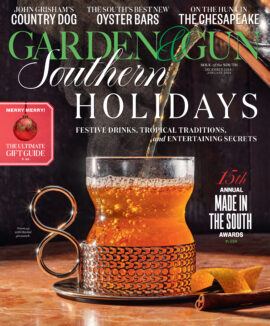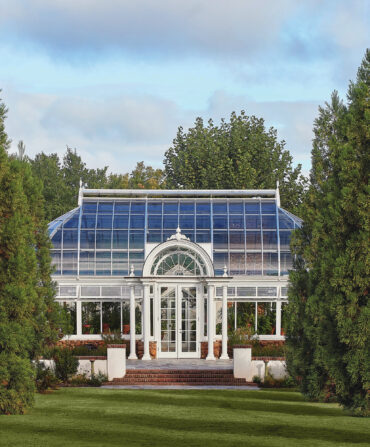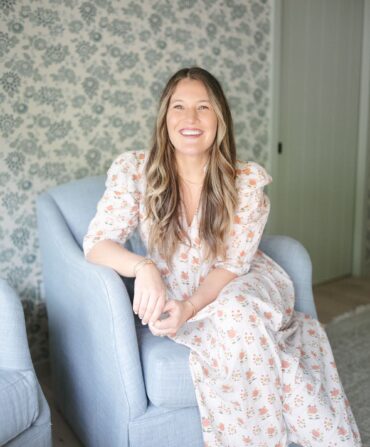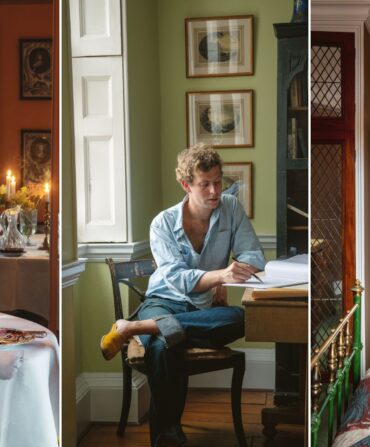Helping Hand
Jenga Mwendo
Some things even hurricanes and broken levees can’t wash away. When Jenga Mwendo left her job in computer animation in New York to return to her home in New Orleans’ Lower Ninth Ward two years after Katrina, she found a community still floundering in the flood’s aftermath. Helping from literally the roots up, she organized green-thumbed neighbors into the Backyard Gardeners Network and established community gardens that today sprout tomatoes, squash, okra, and a bumper crop of educational programs for families and kids. “The Lower Nine has a strong cultural tradition of growing its own food,” Mwendo says. “One practical reason for promoting self-reliance is to keep us in the mind-set that we can take care of ourselves should disaster strike again.” —backyardgardenersnetwork.org

Photo: Rush Jagoe
Digging In
Produce-growing pioneer Jenga Mwendo, in the Guerrilla Garden in New Orleans’ Lower Ninth Ward.
Preservation Propagators
Tom and Phyllis Hunter
Living on seventy-five acres in Lebanon, Tennessee, once owned by Andrew Jackson might provide enough sense of history for most people. For Tom and Phyllis Hunter, it’s just a start. The property is now home to American Heritage Trees, the couple’s venture to propagate and sell saplings from seeds gathered from a dozen, mostly Southern, historic sites. As if creating an arborist’s version of a fantasy dinner-party guest list, they’ve collected descendants of Southern magnolias from Robert E. Lee’s birthplace in Virginia, red cedars from William Faulkner’s Rowan Oak estate in Mississippi, and burr oaks that a young Samuel Clemens most likely climbed in Missouri. “Each of our trees is an adventure, but I admit getting seeds from Mount Vernon was very exciting,” Tom says. “When the grounds manager handed George Washington’s tree seeds to me, it was a feeling I will never forget.” —americanheritagetrees.org
Welcoming Committee
Will and Anne Massie
“Growing up in Virginia brings a sense that what you do will be inherited, and maybe even closely examined by subsequent generations,” says Anne Massie, who along with her brother, Will, designs and creates heirloom-quality McKinnon and Harris outdoor furniture in Richmond. Named for their garden-loving grandmothers, their workshop handcrafts elegant chairs, tables, and chaise longues that create a welcoming statement in outdoor-entertaining spaces. “To me, the garden is such a part of a house that it doesn’t make sense to put furniture outside that isn’t the equal of the interior,” says Will. But is it still okay to let the dogs on it? “We encourage it!” Anne says. “We actually named our Beaufort collection after an adored Gordon setter from childhood who had a knack for finding the most comfortable seat.” —mckinnonharris.com
Legacy Landscaper
Joseph Hillenmeyer
“It’s not the size of the space as much as how far a client will let me push the envelope,” says Joseph Hillenmeyer, a landscape designer from Lexington, Kentucky. The in-demand thirty-eight-year-old’s words match his bold style, typified by squared-off boxwoods and sculpted patterns placed close to a home to meld the built and natural environments. He’s self-taught, with a big caveat: Hillenmeyers have pursued horticulture in this country for six generations, plus a few more back in France and Germany. Not content to rely on family tradition, he also toured European gardens and even worked at an arboretum near Istanbul. His worldly philosophy now benefits neighbors who have surrendered their yards as laboratories. “Sometimes,” Hillenmeyer says, “landscape design is a long game.” —jhillenmeyer.com

Heather Anne Thomas
Joseph Hillenmeyer at one of his projects in Kentucky.
Change Artist
Tommy Mitchell
Like a successor to sketch-pad-toting botanists of the past, the North Carolina artist Tommy Mitchell, a former art restorer, begins by intently studying local flora, from waist-high tobacco plants to the hyacinths and hellebores blooming in his own Chapel Hill garden. Adapting the centuries-old European tradition of cut-metal tole work, Mitchell meticulously bends, snips, and paints copper, brass, and steel to create startlingly detailed, lifelike sculptures that have captivated both interior designers and the likes of the retailer Bergdorf Goodman. The impression of realism is hard to shake even when a piece is finished with a modern whitewash, or incorporated into his furniture and lighting collections. “My approach actually isn’t to mimic nature,” Mitchell says, “it’s to be inspired and find energy there.” —tommymitchellcompany.com
Rose Rescuer
Mike Shoup
Burly and bearded, Mike Shoup doesn’t match the prim stereotype of a rose aficionado. Then again, the roses at his Antique Rose Emporium in Brenham, Texas, don’t match the perception of fussy ornamentals that require constant care. As a struggling nurseryman in the 1980s, he stumbled upon gorgeous roses thriving in cemeteries and abandoned lots despite decades of neglect—and a business was born. “They don’t die like finicky modern roses,” says Shoup, who has collected hundreds of “survivor” varieties. “Mother Nature has already selected the toughest roses to go forward.” Mysteries have been solved, too, as when a senior citizen shared cuttings of a rose her mother had tended. Faded catalogues identified it as the forgotten Louis Philippe rose introduced by a minister to France in the 1840s, when Texas was still a republic. —antiqueroseemporium.com

Wynn Myers
Mike Shoup at his Antique Rose Emporium.
Magnolia Master
Erin Weston
Erin Weston’s wreaths and garlands made of magnolia leaves are undeniably Southern, and like all things Southern, they come with a deep backstory: The land that became Weston Farms, where she cultivates four thousand orderly magnolias just south of Raleigh, was originally purchased by her grandfather, a part-time televangelist, and later used by her father to raise millions of aquarium-bound guppies. Weston herself studied art history, and worked in publishing in New York City until she inherited the homeplace in 2002. That’s when a cutting transplanted from her grandmother’s prized magnolia served as the seed for an entrepreneurial venture. Each holiday season, Weston harvests the best leaves with lustrous green fronts and brown backs to create festive decorations. “They appear to be dipped in chocolate velvet,” she says. And since the magnolia leaves age beautifully without withering, a Weston Farms wreath is an heirloom that can become part of your own family story, too. —westonfarms.com
Seed Queen
Ira Wallace
Back before heirloom became a buzzword, Ira Wallace was already saving rare seeds for the day when we’d all go crazy for tomatoes with names like Cherokee Purple and Yellow Oxheart. As an owner of the Southern Exposure Seed Exchange in Mineral, Virginia, Wallace spreads her contagious gardening gospel across the country and helps publish the exchange’s influential annual catalogue. On its pages appear more than seven hundred heirloom and open-pollinated seeds especially adapted to Southern growing conditions, and you can bet that Wallace knows them all from artichoke to zucchini—including more than a hundred tomato varieties of every size, color, and flavor profile. “Questions about the food system have led many of us toward local and organic food,” she says, “and what food is more local than food from your own backyard?” —southernexposure.com

Bill Phelps
Seed cataloguer Ira Wallace.
Sun Worshippers
Alan and Nancy Virts
“No matter how many rooms a house has, a conservatory becomes the favorite room,” says the architect Alan Virts. He and his wife, Nancy, should know: Their Denton, Maryland–based company, Tanglewood Conservatories, has specialized in the structures for more than twenty years. In the Victorian era, conservatories were all the rage as showplaces that nurtured exotic plants from rare orchids to potted palms. Today, Tanglewood fashions steel, glass, and mahogany into dramatic domes and expansive windows that honor classic architectural styles from Georgian to art nouveau. “Wherever conservatories are, there is something magical about the quality of light,” Nancy says. “It’s the beauty you see inside while you also see the beauty outside.” —tanglewoodconservatories.com
Flower Girl
Ariel Dearie
Five years ago, Louisiana native and New York transplant Ariel Dearie abandoned her idea of opening a bakery and began working in flowers. But when she partnered with set designer and fellow New Orleanian Mary Howard to create arrangements of camellia leaves and fresh gardenias for a photo shoot with the famed photographer Annie Leibovitz, her career truly bloomed. Now Dearie’s creations—from dramatic, six-foot walls of heirloom roses to more approachable arrangements heavy on Southern smilax vine and magnolia—are in high demand for weddings, events, and ad campaigns for such brands as Anna Sui and Bulgari. That doesn’t stop her from getting back to New Orleans, though. “I return often and sometimes take a boat out in the bayous,” she says. “The overgrown, wild elements there have a big effect on my work.” —arieldearieflowers.com

Tara Donne
Ariel Dearie at work on a custom installation in her Manhattan studio.







